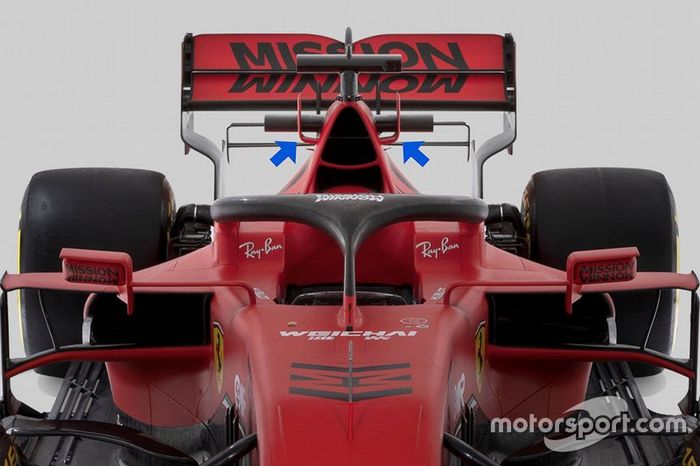This is new: Viking horns, which are mounted on the side of the airbox.
The nose has been refined when we compare it with the design introduced in Singapore last season, with the snowplow under the nose much more pronounced, owing to a redesign on the nose tip. Meanwhile, the caped outer edges of the device have also been reprofiled to maximise their role in generating load at the front of the car.
For comparison, here's the solution introduced by Ferrari in Singapore last season.
The turning vanes have been bought further forward too, with four elements, rather than three housed on the nose. The rearward section, mounted under the chassis, also features an extension of the footplate in order to improve their relationship.
Ferrari has once again maximised the height of the bargeboards, as at first glance the three sections at the front of the assembly appear to be higher than the regulations would permit.
The bargeboards themselves are relatively conventional with multiple surfaces and slots ensuring they operate well over a range of angles, speeds and conditions. The boomerangs have been optimised further, with a thinner element deployed above the assembly's leading edge, while a chunkier one obliges at the rear. Both of these elements are contorted at their outermost point in order that they form the first part of the deflector array, which are also shaped to form a cluster of winglets around the floor's axehead.
Here we can see last year's bargeboard design, which acts as a good comparison when viewing the new configuration.
Behind this we find the main three panels that make up the deflector array, the forwardmost two of which follow in the teams recent lineage of L-shaped appendages, whilst the upper panel has been simplified and detached from the upper sidepod slat.
Ordinarily arched down the slat follows a trend employed by Red Bull for the last few seasons, which likely creates a counter-rotating vortex to the one ordinarily found at the surface's outer tip. Its use of this sidepod slat has led to the team making similar changes to their overall sidepod bodywork geometry and once again sees the overall size of the inlet buried beneath the bodywork made smaller still.
The originators of the two-piece mirror trend, Ferrari had stepped back from this in recent years…
However, the SF1000 features a convoluted mirror stalk assembly and two-piece mirror setup once more.
From the side view it’s pretty clear to see that this year’s car has grown in length once more, the team using that as a way of repackaging the power unit, ancillaries and gearbox in order to reduce the overall width of the bodywork.
This is further evidenced by the massive expanse at the rear of the floor into the coke bottle region, made possible by the tight, jelly mould-style sidepod packaging.




























Top Comments